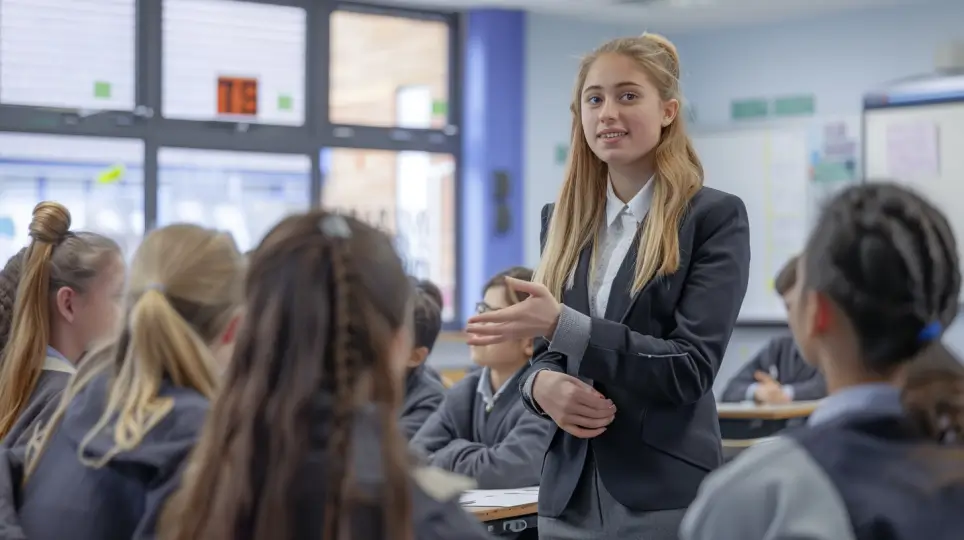Responsive Teaching
Explore the core of responsive teaching: adapting strategies to meet diverse student needs, fostering an inclusive and dynamic learning environment.
Explore the core of responsive teaching: adapting strategies to meet diverse student needs, fostering an inclusive and dynamic learning environment.
Responsive teaching represents a dynamic approach to education, where effective teachers adapt their strategies based on the evolving needs of their students. At its core, responsive teaching is about observing, understanding, and acting on the cues students provide during their learning journey. This method acknowledges that each classroom is unique and that a one-size-fits-all approach to teaching often falls short of reaching every learner.
Originating from key ideas in cognitive science, responsive teaching emphasizes the importance of tailoring instruction to support individual student understanding. Cognitive science, a field that Dylan Wiliam and other educational thinkers often draw upon, offers insights into how students think, learn, and retain information. By applying these insights, a responsive teacher becomes adept at planning lessons that not only cover the curriculum but also engage students in meaningful ways.
Effective teaching within this framework requires a continuous loop of feedback and adaptation. The classroom teacher, acting as both guide and observer, adjusts their approach to teaching based on real-time student responses. This could mean altering a lesson plan on the spot, introducing new materials to clarify a concept, or modifying group activities to better suit the learners' needs.
Responsive teaching is not without its challenges. It demands a high degree of flexibility and creativity from educators, as well as a deep understanding of the subject matter and pedagogical principles. However, the rewards are significant. Schools in the UK and beyond that embrace responsive teaching often report higher levels of student engagement, deeper understanding of subject content, and improved academic outcomes.
Key Takeaways:
Each of the following formative assessment techniques serves as a crucial component of responsive teaching. By continuously gathering data on student understanding and engagement, educators can adapt their strategies in real-time, ensuring every learner's needs are met, and fostering an environment of success and progress.

Utilizing the philosophy of responsive teaching in the realm of literacy involves a nuanced understanding of each student's unique needs and leveraging this insight to adapt instructional strategies effectively. In the literacy context, this means crafting lessons that are as dynamic and diverse as the learners themselves, guided by careful observation and a profound understanding of literacy principles.
Authentic Literacy Experiences and High-Quality Texts:
Observation and Assessment to Inform Teaching: Responsive teaching in literacy hinges on the careful observation of students' interactions with reading and writing. This ongoing assessment forms the backbone of instructional decisions, enabling educators to:
Shared Language and Consistent Expectations:
Each student enters the classroom with a distinct set of experiences and capabilities. Recognizing and honoring these differences is crucial. Responsive teaching is not merely about planning lessons; it's about adapting those plans in real-time, responding to the immediate needs of students.

These studies collectively emphasize the significance of responsive teaching practices through formative assessment, illustrating various approaches across disciplines to adapt teaching in real time based on student feedback and learning needs.
Responsive teaching represents a dynamic approach to education, where effective teachers adapt their strategies based on the evolving needs of their students. At its core, responsive teaching is about observing, understanding, and acting on the cues students provide during their learning journey. This method acknowledges that each classroom is unique and that a one-size-fits-all approach to teaching often falls short of reaching every learner.
Originating from key ideas in cognitive science, responsive teaching emphasizes the importance of tailoring instruction to support individual student understanding. Cognitive science, a field that Dylan Wiliam and other educational thinkers often draw upon, offers insights into how students think, learn, and retain information. By applying these insights, a responsive teacher becomes adept at planning lessons that not only cover the curriculum but also engage students in meaningful ways.
Effective teaching within this framework requires a continuous loop of feedback and adaptation. The classroom teacher, acting as both guide and observer, adjusts their approach to teaching based on real-time student responses. This could mean altering a lesson plan on the spot, introducing new materials to clarify a concept, or modifying group activities to better suit the learners' needs.
Responsive teaching is not without its challenges. It demands a high degree of flexibility and creativity from educators, as well as a deep understanding of the subject matter and pedagogical principles. However, the rewards are significant. Schools in the UK and beyond that embrace responsive teaching often report higher levels of student engagement, deeper understanding of subject content, and improved academic outcomes.
Key Takeaways:
Each of the following formative assessment techniques serves as a crucial component of responsive teaching. By continuously gathering data on student understanding and engagement, educators can adapt their strategies in real-time, ensuring every learner's needs are met, and fostering an environment of success and progress.

Utilizing the philosophy of responsive teaching in the realm of literacy involves a nuanced understanding of each student's unique needs and leveraging this insight to adapt instructional strategies effectively. In the literacy context, this means crafting lessons that are as dynamic and diverse as the learners themselves, guided by careful observation and a profound understanding of literacy principles.
Authentic Literacy Experiences and High-Quality Texts:
Observation and Assessment to Inform Teaching: Responsive teaching in literacy hinges on the careful observation of students' interactions with reading and writing. This ongoing assessment forms the backbone of instructional decisions, enabling educators to:
Shared Language and Consistent Expectations:
Each student enters the classroom with a distinct set of experiences and capabilities. Recognizing and honoring these differences is crucial. Responsive teaching is not merely about planning lessons; it's about adapting those plans in real-time, responding to the immediate needs of students.

These studies collectively emphasize the significance of responsive teaching practices through formative assessment, illustrating various approaches across disciplines to adapt teaching in real time based on student feedback and learning needs.